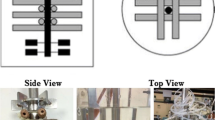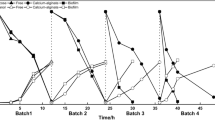Abstract
We previously found that some Saccharomyces cerevisiae and Lactobacillus plantarum remarkably formed mixed-specie biofilm in a static co-culture and deduced that this biofilm had potential as immobilized cells. We investigated the application of mixed-specie biofilm formed by S. cerevisiae BY4741 and L. plantarum HM23 for ethanol fermentation in repeated batch cultures. This mixed-specie biofilm was far abundantly formed and far resistant to washing compared with S. cerevisiae single biofilm. Adopting mixed-specie biofilm formed on cellulose beads as immobilized cells, we could produce enough ethanol from 10 or 20 % glucose during ten times repeated batch cultures for a duration of 10 days. Cell numbers of S. cerevisiae and L. plantarum during this period were stable. In mixed-specie biofilm system, though ethanol production was slightly lower compared to S. cerevisiae single-culture system due to by-production of lactate, pH was stably maintained under pH 4 without artificial control suggesting high resistance to contamination. Inoculated model contaminants, Escherichia coli and Bacillus subtilis, were excluded from the system in a short time. From the above results, it was indicated that the mixed-specie biofilm of S. cerevisiae and L. plantarum was a promising immobilized cell for ethanol fermentation for its ethanol productivity and robustness due to high resistance to contamination.





Similar content being viewed by others
References
Aoi, Y. (2002). Journal of Bioscience and Bioengineering, 94, 552–556.
Cao, N., Du, J., Chen, C., Gong, C. G., & Tsao, G. T. (1997). Applied Biochemistry and Biotechnology, 63–65, 387–394.
Costerton, J. W., Lewandowski, Z., Caldwell, D. E., Korber, D. R., & Lappin-Scott, H. M. (1995). Annual Review of Microbiology, 49, 711–745.
Costerton, J. W., Stewart, P. S., & Greenberg, E. P. (1999). Science, 284, 1319–1322.
Davey, M. E., & O’Toole, G. A. (2000). Microbiology and Molecular Biology Reviews, 64, 847–867.
Demirci, A., Pometto, A. L., & Ho, K. L. (1997). Journal of Industrial Microbiology and Biotechnology, 19, 299–304.
Furukawa, S., Kuchma, S. L., & O’Toole, G. A. (2006). Journal of Bacteriology, 188, 1211–1217.
Furukawa, S., Nojima, N., Yoshida, K., Ogihara, H., & Morinaga, Y. (2011). Bioscience Biotechnology and Biochemistry, 75, 1430–1434.
Furukawa, S., Yoshida, K., Ogihara, H., Yamasaki, M., & Morinaga, Y. (2010). Bioscience Biotechnology and Biochemistry, 74, 2136–2139.
Gomez, M. A., Galvez, J. M., Hontoria, E., & Gonzalez-Lopez, J. (2003). Journal of Bioscience and Bioengineering, 95, 245–251.
Kolter, R., & Greenberg, E. P. (2006). Nature, 441, 300–302.
Kumar, C. G., & Anand, S. K. (1998). International Journal of Food Microbiology, 42, 9–27.
Martin, K. J., & Nerenberg, R. (2012). Bioresource Technology, 122, 83–94.
Monds, R. D., & O’Toole, G. A. (2009). Trends in Microbiology, 17, 73–87.
Okazaki, S., Furukawa, S., Ogihara, H., Kawarai, T., Matsuo, H., Kitada, C., et al. (2010). Journal of General and Applied Microbiology, 56, 205–211.
Pongtharanqkul, T., & Demirci, A. (2006). Biotechnology Progress, 22, 217–224.
Rangaswamy, V., & Ramakrishna, S. V. (2008). Letters in Applied Microbiology, 46, 661–666.
Romano, J. D., & Kolter, R. (2005). Journal of Bacteriology, 187, 940–948.
Shore, J. L., M’Coy, W. S., Gunsch, C. K., & Deshusses, M. A. (2012). Bioresource Technology, 112, 51–60.
Terada, A., Hibiya, K., Nagai, J., Tsuneda, S., & Hirata, A. (2003). Journal of Bioscience and Bioengineering, 95, 170–178.
Urbance, S. E., Pometto, A. L., 3rd, Dispirito, A. A., & Denli, Y. (2004). Applied Microbiology and Biotechnology, 65, 664–670.
Wood, B. J. B. (1998). Microbiology of Fermented Foods. London: Blackie Academic and Professional.
Wood, B. J. B. (1981). In M. E. Bushell & J. H. Slater (Eds.), Mixed Culture Fermentations (pp. 137–150). London: Academic.
Zottola, E. A., & Sasahara, K. C. (1994). International Journal of Food Microbiology, 23, 125–148.
Acknowledgments
This work was supported by a Grant-in-Aid for Scientific Research (Wakate B & Kiban C) to SF from MEXT; the Ministry of Education, Culture, Sports, Science and Technology of Japan; High-Tech Research Center Project for Private Universities; Matching Fund Subsidy to SF; and MEXT and Adaptable and Seamless Technology Transfer Program through target drive R&D to YM from Japan Science and Technology Agency.
Author information
Authors and Affiliations
Corresponding authors
Rights and permissions
About this article
Cite this article
Abe, A., Furukawa, S., Watanabe, S. et al. Yeasts and Lactic Acid Bacteria Mixed-Specie Biofilm Formation is a Promising Cell Immobilization Technology for Ethanol Fermentation. Appl Biochem Biotechnol 171, 72–79 (2013). https://doi.org/10.1007/s12010-013-0360-6
Received:
Accepted:
Published:
Issue Date:
DOI: https://doi.org/10.1007/s12010-013-0360-6




